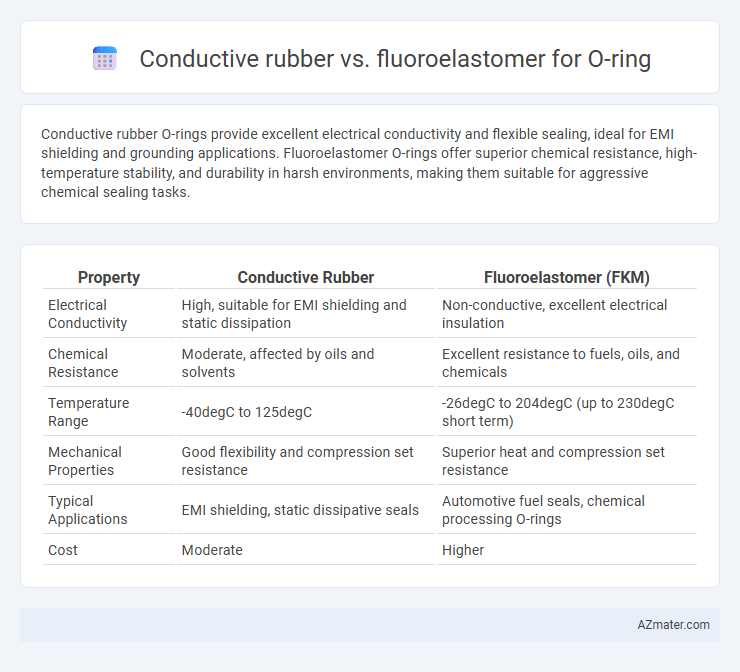Conductive rubber O-rings provide excellent electrical conductivity and flexible sealing, ideal for EMI shielding and grounding applications. Fluoroelastomer O-rings offer superior chemical resistance, high-temperature stability, and durability in harsh environments, making them suitable for aggressive chemical sealing tasks.
Table of Comparison
| Property | Conductive Rubber | Fluoroelastomer (FKM) |
|---|---|---|
| Electrical Conductivity | High, suitable for EMI shielding and static dissipation | Non-conductive, excellent electrical insulation |
| Chemical Resistance | Moderate, affected by oils and solvents | Excellent resistance to fuels, oils, and chemicals |
| Temperature Range | -40degC to 125degC | -26degC to 204degC (up to 230degC short term) |
| Mechanical Properties | Good flexibility and compression set resistance | Superior heat and compression set resistance |
| Typical Applications | EMI shielding, static dissipative seals | Automotive fuel seals, chemical processing O-rings |
| Cost | Moderate | Higher |
Introduction to O-Ring Materials
O-ring materials like conductive rubber and fluoroelastomer are essential for sealing applications in diverse industries. Conductive rubber provides excellent electrical conductivity and static dissipation, making it ideal for electronics and anti-static environments. Fluoroelastomer offers superior chemical resistance, high-temperature tolerance, and durability, commonly used in automotive and aerospace seals.
Overview of Conductive Rubber
Conductive rubber is a specialized elastomer embedded with conductive fillers such as carbon black or metal particles, enabling it to dissipate static electricity and provide electromagnetic interference (EMI) shielding. This material combines flexibility and resilience with electrical conductivity, making it ideal for O-rings in electronic sealing applications where grounding or shielding is critical. Compared to fluoroelastomers, conductive rubber offers superior conductivity but may have lower chemical resistance and temperature tolerance.
Overview of Fluoroelastomer (FKM)
Fluoroelastomer (FKM) O-rings offer superior chemical resistance, high temperature stability up to 200degC, and exceptional durability in harsh environments compared to conductive rubber. These elastomers are widely used in automotive, aerospace, and chemical processing industries where resistance to fuels, oils, and aggressive chemicals is critical. The low permeability and excellent sealing performance of FKM make it a preferred choice for applications requiring long-term reliability and minimal maintenance.
Key Applications of Conductive Rubber O-Rings
Conductive rubber O-rings are essential in electronic enclosures, providing electromagnetic interference (EMI) shielding and static discharge protection in devices like smartphones, medical equipment, and aerospace components. They ensure reliable grounding and maintain signal integrity in sensitive electronic assemblies. In contrast, fluoroelastomer O-rings excel in chemical resistance and high-temperature sealing but lack the electrical conductivity required for EMI shielding applications.
Key Applications of Fluoroelastomer O-Rings
Fluoroelastomer O-rings excel in high-temperature and chemically aggressive environments, making them ideal for aerospace fuel systems, automotive engine seals, and chemical processing equipment. Their superior resistance to oils, fuels, and solvents ensures long-term sealing performance under extreme conditions. This durability provides a critical advantage over conductive rubber O-rings, which are primarily suited for electrical conductivity applications but lack the chemical and thermal resistance necessary for harsh industrial uses.
Chemical Resistance Comparison
Fluoroelastomer O-rings offer superior chemical resistance against a wide range of aggressive fluids, including oils, fuels, and acids, making them ideal for harsh chemical environments where conductive rubber may degrade. Conductive rubber O-rings provide moderate chemical resistance but excel in applications requiring static dissipation or electrical conductivity, often failing in exposure to strong solvents or high-temperature chemicals. The choice between conductive rubber and fluoroelastomer hinges on the specific chemical exposure, temperature conditions, and the need for conductivity within the sealing application.
Electrical Properties and Performance
Conductive rubber O-rings exhibit excellent electrical conductivity, making them ideal for EMI shielding and grounding applications, whereas fluoroelastomer O-rings provide superior chemical resistance but lack inherent conductivity. Conductive rubber typically incorporates carbon or metal fillers to achieve surface resistivity values as low as 10^-2 ohm-cm, enhancing electrical performance under compression. In contrast, fluoroelastomers offer dielectric strengths up to 40 kV/mm, ensuring excellent insulation rather than conductivity in harsh environments.
Temperature Resistance and Durability
Conductive rubber O-rings offer moderate temperature resistance, typically operating effectively between -40degC to 120degC, with good durability in low to medium heat applications. Fluoroelastomer O-rings, such as Viton(r), excel in high-temperature environments, with resistance up to 200degC or higher and superior chemical stability, enhancing long-term durability in harsh conditions. The choice depends on the application's thermal demands and exposure to aggressive chemicals, where fluoroelastomers provide enhanced performance and lifespan under extreme temperatures.
Cost and Availability Factors
Conductive rubber O-rings generally offer lower cost and greater availability due to widespread production and use in various industries requiring electrical conductivity and grounding. Fluoroelastomer O-rings, while more expensive, provide superior chemical resistance and high-temperature stability but are less commonly stocked, leading to longer lead times. Cost-effective projects with standard sealing needs often favor conductive rubber, whereas fluoroelastomers are preferred for specialized applications despite higher initial investment and limited immediate availability.
Choosing the Right O-Ring Material for Your Application
Conductive rubber O-rings provide excellent electrical conductivity and are ideal for applications requiring static discharge or electromagnetic interference (EMI) shielding. Fluoroelastomer O-rings offer superior chemical resistance, high temperature tolerance up to 200degC, and excellent durability in aggressive environments such as fuels and oils. Selecting the right O-ring material depends on specific operational needs like conductivity, chemical exposure, temperature range, and mechanical stress to ensure optimal sealing performance and longevity.

Infographic: Conductive rubber vs Fluoroelastomer for O-ring
 azmater.com
azmater.com